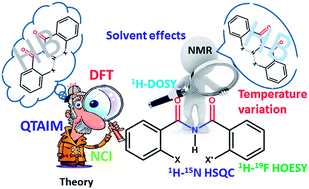Organic fluorine involved intramolecular hydrogen bonds in the derivatives of imides: NMR evidence corroborated by DFT based theoretical calculations†
Abstract
The rare occurrence of intramolecular hydrogen bonds (HBs) of the type N–H⋯F–C is detected in the derivatives of imides in a low polarity solvent by using multi-dimensional and multinuclear NMR experiments. The observation of 1hJFH, 2hJFN, and 2hJFF, where the spin magnetization is transmitted through space among the interacting NMR active nuclei, provided strong and unambiguous evidence for the existence of intra-molecular HBs. The variation in the chemical shifts of labile protons depending on physical conditions, such as the solvent dilution and the systematic alteration of temperature confirmed the presence of weak interactions through intramolecular HBs in all the investigated fluorine substituted molecules. The self or cross dimerization of molecules is unequivocally discarded by the analysis of the rates of diffusion obtained using pseudo-two dimensional DOSY experiments. The Density Function Theory (DFT) calculations based on the Quantum Theory of Atoms In Molecules (QTAIM) and Non Covalent Interaction (NCI), are in close agreement with the NMR experimental findings.


 Please wait while we load your content...
Please wait while we load your content...